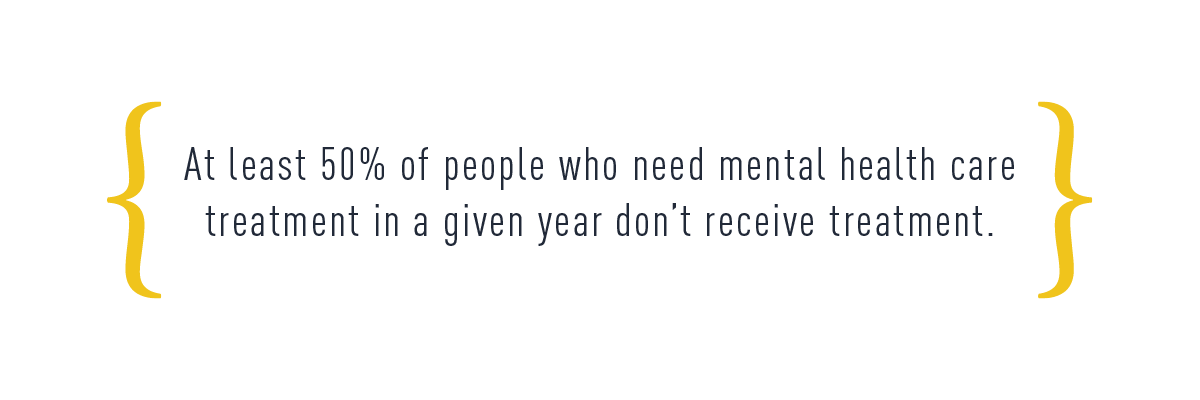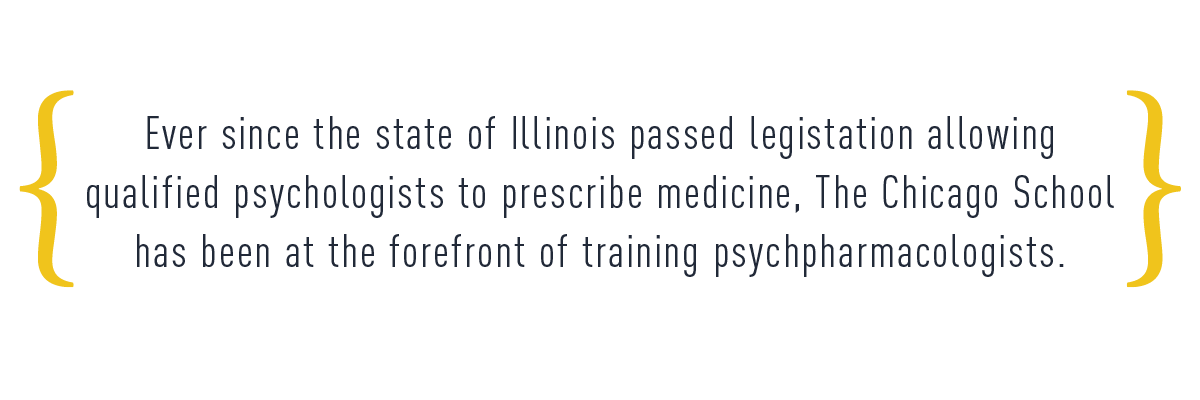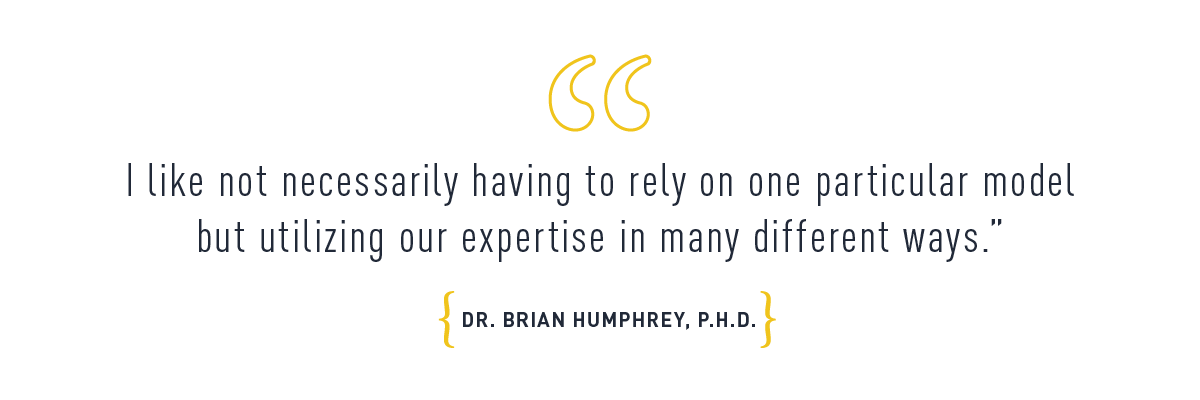Brian Humphrey, Ph.D., graduate of The Chicago School and clinical and prescribing psychologist at PsychSynergy Behavioral Health, was approached by a physician colleague about an adolescent patient whose mother said he was “hyper, disruptive in the classroom, an uncontrollable ball of energy.” Testing seemed to confirm a diagnosis of ADHD, but the patient’s mother was concerned about the long-term effects of medication.
Dr. Humphrey did some digging into the child’s home life and discovered that he was adding sugar to his Frosted Flakes at breakfast and eating extra sweet snacks during the day. “His behavioral presentation was from sugar, not a neurological issue,” Dr. Humphrey says. “We prevented this kid from getting a diagnosis that would’ve probably been with him for life and from taking medication needlessly.”
This interaction among a child, a parent, a medical doctor, and a prescribing psychologist illustrates how decisions regarding behavioral and physical traits and symptoms can influence when and when not to prescribe medicine. It also demonstrates an integrated approach to health that addresses both the mind and the body to improve patient outcomes.

Prescribing Psychologists Meet a Need
In the United States, medications intended to treat psychological or behavioral disorders are prescribed by professionals with medical degrees, most commonly psychiatrists. However, psychologists with specialized certification can currently prescribe medication in the military and in seven U.S. states, with that number expected to rise significantly over the next decade. There are several reasons for this. According to Gerardo Rodriguez-Menendez, Ph.D., department chair in the Clinical Psychopharmacology program, demand is the primary factor guiding the expansion of states allowing qualified psychologists to prescribe. According to a range of studies from the American Psychological Association and other organizations, he says, “At least 50% of people who need mental health care treatment in a given year don’t receive treatment.”

Dr. Rodriguez-Menendez suggests several causes for this national health challenge. The first, he says, is that psychiatrists are mainly concentrated in urban areas, with 50% of counties across the United States reporting no psychiatric services, adding, “When you’re talking about rural counties, that number jumps up to 80% that do not offer psychiatric services.” Second, roughly half of all practicing psychiatrists are fee-for-service practices that do not accept insurance. This policy further skews treatment data toward wealthier, whiter clients. “If a person is male, Hispanic or Black, their chance of getting treatment is only about 35%,” Dr. Rodriguez-Menendez explains, “which means 65% of these individuals go without any treatment who need services.” He believes that this is an area where an increase in the number of prescribing psychologists can have an immediate impact, pointing out that there are four times as many psychologists as there are psychiatrists.

Providing Services Where They Are Needed
These demographic discrepancies are part of what inspired Dr. Humphrey to become a prescribing psychologist. His practice is located in Oak Park, a western suburb of Chicago, near the Austin neighborhood on the city’s west side—the location of his childhood home, where he witnessed the ongoing challenges of addiction and gun violence. In addition to the stigma against seeking mental health care among many in the community, there is a deep-seated suspicion of using medication to treat psychological issues. This is where being part of the community is a benefit for a clinical psychologist, being able to partner with individuals or organizations that can help, whether it is a medical doctor or a church.
Additionally, Dr. Humphrey believes that having the training that granted him prescribing authority is an added benefit. “I’ve had a greater appreciation of being able to differentiate physical health conditions that may masquerade or resemble mental health conditions,” he says, such as the case of the child on the sugar high.
Dr. Humphrey provides another example of a patient diagnosed with anxiety who was adamant that he did not want to take medication for fear that he may become addicted, not an uncommon concern among his clients. While Dr. Humphrey felt in that situation a prescription would have yielded the best and fastest results, he applied cognitive behavioral therapy and other empirically validated treatments. With that approach, the patient was able to get his symptoms under control. Thus, the training for prescriptive authority may, in many cases, mean deprescribing or not prescribing in the first place.
Another tool in Dr. Humphrey’s bag is ethnopsychopharmacology, which he describes as “precision medicine adapting practices to being more ethnocentric and more culturally relevant.” As an example, he points to the fact that there are certain enzymes and enzyme systems within African Americans that may process and break medications down slowly. Therefore, rather than administering the commonly prescribed dosage, he says, “Having that cultural appreciation, that ethnic, nuanced understanding will allow a person to be informed to say, ‘Maybe we’ll start with half and have a greater focus on side effects.’”

A Model for Integrated Health Care
With the stresses on the American healthcare system, administrators and providers are looking for ways to deliver integrated services where they are needed most. Toward that objective, prescribing psychologists may offer a glimpse into what successful healthcare integration looks like. “As a psychologist, I have the ability to cross that bridge between traditional psychotherapy and traditional scientific, medical, physical health,” Dr. Humphrey says.
In his view, prescribing psychologists can function as psychologists first while also tapping into their psychopharmaceutical skill set when necessary, within various community settings and in their practices. Doing so allows them to serve a lot more individuals in different places, including people who may be resistant to treatment.
“There are a lot of barriers in healthcare, and I would like to see some of those barriers removed,” Dr. Humphrey says. He worries that the “cold handoff” of a referral to another provider can cause a patient to fall through the cracks. “Whereas I have so many relationships with so many individuals where I can call them and say, ‘I have an individual who would greatly benefit from your services.’
As someone who is intentionally practicing in his own community, Dr. Humphrey believes that establishing an ongoing connection with his patients improves outcomes, “whether it’s psychoeducation or rapport-building and the inherent trust that comes from meeting with the person more frequently.”

How The Chicago School Is Meeting the Demand for Prescribing Psychologists
The road to licensure and practice for many prescribing psychologists has traditionally begun with a Ph.D. or Psy.D. in Clinical Psychology followed by a Master of Science in Psychopharmacology. However, that is changing in some cases. “You don’t graduate as a dentist to then come back for three more years of pharmacology training if you want to use Novocain,” Dr. Rodriguez-Menendez says. “That model does not make sense.”

He believes The expansion of states that permit psychologists to prescribe—these include Colorado, Idaho, Illinois, Louisiana, New Mexico, and Utah, with others expected in the near future—has led to a boom in enrollment at The Chicago School, with an increase in enrollment in the Clinical Psychopharmacology programs of 73% between 2024 and 2025, according to Dr. Rodriguez-Menendez. Ever since the state of Illinois passed legislation allowing qualified psychologists to prescribe medication, The Chicago School has been at the forefront of training psychopharmacologists.
In response to feedback from their students and graduates, The Chicago School is streamlining its psychopharmacology programs, including a Certificate in Clinical Rotations for Clinical Psychopharmacology program. Clinical rotations now appear on transcripts, a step that addresses students’ concerns about delays between completing rotations and obtaining licensing and of state licensing boards that would prefer to see clinical training administratively overseen by an accredited university. Finally, The Chicago Psychopharmacology Examination for Psychologists (PEP) review course helps students prepare for the national psychopharmacology licensing exam.

A Way to Wellness
Prescribing psychologists who work at the intersection of behavioral and physical health have a deep appreciation for the nexus between mind and body. Dr. Humphrey points to the Illinois College of Osteopathic Medicine at The Chicago School, which will prioritize mental health care as part of its curriculum, as another example of how an integrated approach can best serve communities.

“It speaks to the spirit of holistic care and using available resources,” Dr. Humphrey says, “and I like not necessarily having to rely on one particular model but utilizing our expertise in many different ways.”
As more states pass legislation permitting qualified psychologists to prescribe medication, the horizons of possibilities for effective integrated healthcare will continue to broaden. With frontline providers and system administrators seeking to improve outcomes for an aging population, innovation and reimagination are the orders of the day.
For information on Psychopharmacology and the other program at the Chicago School, please fill out the form below.

